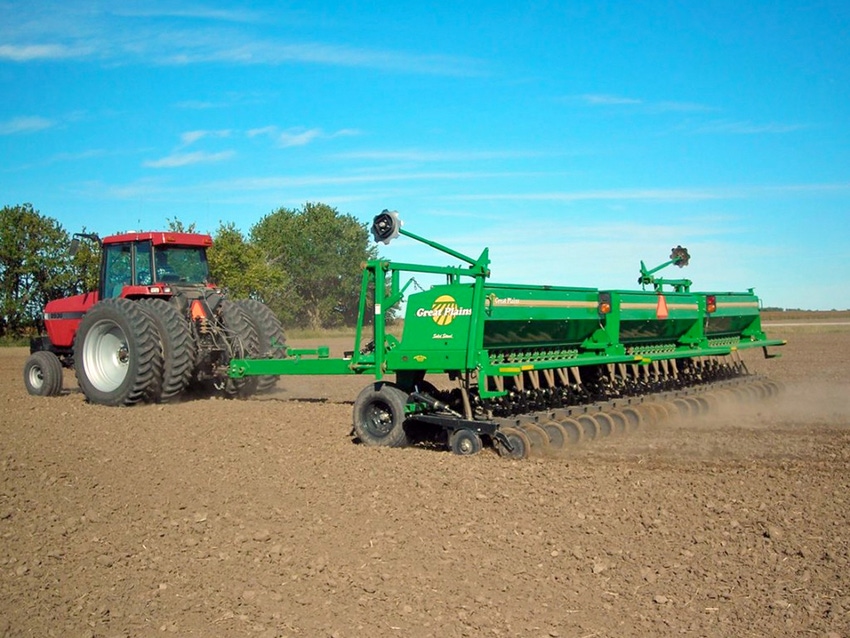October 5, 2011

Planting wheat early is very tempting, but can limit wheat grain productivity more than any other factor. In fact, our record wheat yields this year were likely promoted by dry conditions which delayed planting until early November last fall.
Records from the Kentucky Wheat Production Contest (where winners typically produce more than 100 bushels per acre) justify the significance of timely planting. Top-yielding plots rarely result from plantings prior to the recommended dates.
Planting wheat early needlessly exposes it to developmental, fertility, weed and numerous pest problems which ultimately limit yield potential. Our mild Southern winters further intensify this issue, because the onset and degree of wheat dormancy may vary considerably from year to year. Thus, the developmental advantages gained from planting summer crops early, such as corn and soybeans, do not apply to winter wheat.
The adverse effects from excessive fall growth include spring freeze injury, development of barley yellow dwarf virus, Hessian fly and armyworm infestation, more disease infection, more weed competition, poor nutrient use, and increased lodging.
Growers in both north and south Mississippi have experienced severe freeze injury during recent seasons and ensuing yield loss generally increases drastically with early-maturing wheat. Thus, we need to carefully manage variety maturity and planting date, because both factors affect wheat maturity.
Early-maturing varieties should be planted later than normal, to avoid excessive development, which could expose them to substantial freeze damage in the spring. Conversely, late-maturing wheat varieties should be planted before early varieties. We should also plant multiple varieties differing in maturity, to spread risk, since seasonal temperatures also influence maturity.
Planting dates
Our suggested wheat planting dates (within 10 to 14 days of the average first fall freeze date) should provide warm enough temperatures and long enough days for seedling emergence and tillering to begin before dormancy occurs. This can vary considerably depending upon seasonal temperatures, but normally corresponds to:
• North and central Mississippi: Oct. 15 to Nov. 10.
• Delta region: Oct. 20 to Nov. 15
• South Mississippi: Nov. 1 to Nov. 25
• Coastal region: Nov. 15 to Dec. 10
Grain drill
Although wheat may be successfully established using various rudimentary broadcast planting methods, I generally recommend planting your grain crop with a drill to optimize stand establishment, vigor and seedling survival. By planting wheat with a grain drill using sound management techniques, you can use more conservative wheat seeding rates without reducing productivity.
While it is important to strive for specific planting standards, wheat does have outstanding capability to compensate for wide variation of plant density. Our normal planting recommendation is to strive to establish 1 million to 1.3 million wheat plants per acre or 23 to 30 plants per square foot.
Seeding rates
Wheat seed size can range from 11,000 to 18,000 seeds per pound (it should be noted on the tag), so base your seeding rate on the number of seeds (seeds per pound), rather than on the volume or weight of the seeds (bushels per acre).
Using these strategies may reduce your seeding rate by more than 50 percent and/or allow you to plant superior varieties on twice as many acres. Only a few situations justify drilling higher seeding rates than normal (10 to 20 percent), including no-tillage or extremely late plantings, for adequate stand establishment.
Raised beds
Some have asked about broadcast planting on raised beds (primarily to facilitate irrigation of the subsequent double-crop), and this method can be productive, depending primarily upon adequate soil-water drainage. However, the appropriate seeding rate for broadcasting and incorporating seed is considerably higher (40 to 45 seeds per square foot), because emergence success will likely be modest (60 to 70 percent of planted seed).
Growers broadcasting small grain seed on the soil surface should generally utilize very high seeding rates (50 to 60 seeds per square foot), because emergence and seedling survival can be relatively low (around 50 percent of planted seed).
For more information, please refer to Publication 2401 Planting Methods and Seeding Rates for Small Grain Crops.
Weed control
It is essential to kill weeds before planting wheat. A burndown herbicide applied prior to planting and/or before crop emergence is necessary to eliminate weed competition during emergence and early tillering stages, particularly in a no-tillage system.
Tillage may also serve the same purpose in conventionally prepared seedbeds. In fact, tillage may be the most practical option to control volunteer Roundup Ready corn prior to planting wheat.
Maintaining a weed-free environment during planting and stand establishment is essential because weeds are very competitive with young wheat plants, particularly if they emerge before or at a similar time as the wheat crop.
Likewise, don’t fall into the assumption that wheat weed control is easy and can wait until springtime. I believe this is where we often leave a lot of wheat yield potential on the table.
Abundant populations of quick-starting weeds, including henbit and annual bluegrass, may intensely compete with wheat for over 100 days, if left unimpeded until the spring. Of course, ryegrass remains a foremost problem.
I encourage you to use fall-applied herbicides to control these weeds during the fall, if they are thick, because competition will rob valuable nutrients and reduce wheat tillering. Thus, fewer wheat heads will be produced next spring. Fall weed control is particularly important if you are not blessed with an optimal stand.
There are a few herbicide options labeled for either preplant, pre-emergence or early postemergence use on wheat, so if you would like some assistance with these, we would be happy to help. 2,4-D should not be applied early postemergence to wheat in the fall, because wheat is intolerant during seedling and early tillering stages.
You May Also Like




